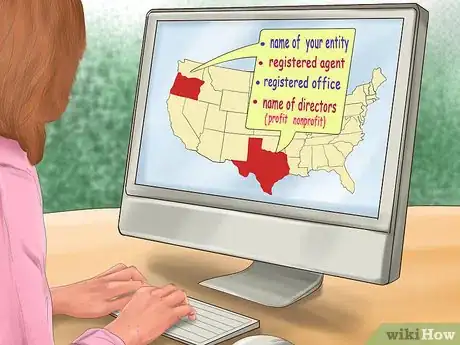This article was co-authored by Clinton M. Sandvick, JD, PhD. Clinton M. Sandvick worked as a civil litigator in California for over 7 years. He received his JD from the University of Wisconsin-Madison in 1998 and his PhD in American History from the University of Oregon in 2013.
There are 20 references cited in this article, which can be found at the bottom of the page.
wikiHow marks an article as reader-approved once it receives enough positive feedback. In this case, 85% of readers who voted found the article helpful, earning it our reader-approved status.
This article has been viewed 263,238 times.
If you're an entrepreneur with a viable business idea and a solid business plan, you'll need to know how to register a company before you can start doing business. It's important to understand that your business must be registered properly and comply with tax regulations in order for it to be legal.
Steps
Choosing a Business Structure
-
1Consult an attorney. Starting a business involves making a number of choices that will affect your tax and personal liability. These choices should be made with the help of a business lawyer whenever possible. To find a qualified attorney, ask your friends and family for a referral. If you cannot get a referral from someone close to you, visit your state's bar website and use their lawyer referral service or lawyer search function. For example, in California, you can speak with a professional for free who will analyze your needs and get you in touch with lawyers who can help.[1]
- Before you hire an attorney, make sure you go through an initial consultation. During this consultation, ask the attorney about their experience with creating and registering companies, their level of success, and their history of attorney discipline.
- When you find an attorney you like, be sure to work out an acceptable fee arrangement and get the agreement in writing.
-
2Consider taxes. The way you organize your business will affect the types of taxes you owe and how you file your returns. For example, sole proprietorships and corporations file income tax returns. In contrast, partnerships file information returns, which is a reporting of income and expenses.
- If you create a corporation, the entity itself is subject to corporate income tax at both the state and federal level. Also, all dividends you distribute are subject to individual tax rates on the person's personal tax return.[2]
- If you create a limited liability company (LLC), the Internal Revenue Service (IRS) will treat it as either a corporation, partnership, or as a disregarded entity. Each of these decisions will affect how you pay your taxes.
- If you create a nonprofit, you may qualify for tax exemption at both the federal and state level.
Advertisement -
3Determine how much personal liability you want to face. Certain business structures offer protection from personal liability for the debts of the business. However, these businesses are often more complex and require more paperwork and more reporting. On the other hand, if you choose a business structure that does not relieve you from personal liability, you may be required to pay for the debts of your business out of your own pocket.
- In general, LLCs and corporations offer personal liability protection while sole proprietorships and partnerships usually do not.[3]
-
4Decide how you want to raise funds. Different business structures are required to raise capital in different ways. Before you create and register a company, you will want to consider how effective you are at raising money using different means.
- If you create a corporation, you will have to raise money through loans and personal investments (i.e., the purchase of stocks or the use of venture capitalist firms).
- If you create a nonprofit entity, you will raise money through personal donations and grants.
-
5Think about paperwork. The type of business structure you choose will dictate the type of recordkeeping and reporting you are required to do. In general, corporations will require the most recordkeeping and reporting while partnerships and sole proprietorships will require the least.
- Corporations are often required to maintain contracts, leases and other agreements; licenses and permits; and payroll and personnel files.[4] Corporations are also required to make annual reports in many states.
Planning Your Business
-
1Write out your business plan. A business plan is an essential tool for creating a successful business. It is generally a three to five year roadmap of your business' projections. Every business plan should have the following elements:
- An executive summary, which is a snapshot of your business as a whole.
- A company description, which provides information about what you do and how you are different from other companies.
- A market analysis, which includes a discussion of your industry, target market, and competitors.
- A description of your organization and management, which lays out how you have structured your business (e.g., corporation, nonprofit, partnership).
- A marketing and sales plan, which tells people how you plan to market and sell your product.
- Financial projections, which tells others what type of funding you need and why.
- Funding requests, which are formal offers for people to fund your business.[5]
-
2Choose a name. You are required to have a name for your business at the time you register with the state. You may also be required to include certain information in your business name if you are a corporation or an LLC. When you create a name, think about how your name will look online, on billboards, and in newspapers. You should also think about what the name will make people feel and if it will lure people to do business with you.[6]
- If you are creating a corporation, you will be required to include words like "corporation", "company", or "limited".[7]
- You should register your name as soon as possible with your state. This process is often known as registering your "Doing Business As (DBA)" name. In California, for example, you must register a DBA if you are a corporation, partnership, or sole proprietorship doing business under a name that is not your own. You will register your name with the city or county clerk's office. Once you register the name, you are required to publish it in a newspaper for a specified period of time.
-
3Apply for trademarks. Trademarks protect names, symbols, and logos that distinguish goods and services. Because your name is one of the most important and valuable pieces of your business, you should protect it whenever possible. To apply for a trademark, you will use the online service provided by the United States Patent and Trademark Office.[8]
-
4Find an office address. When you register with your state you will most likely be required to list an office address in your articles of incorporation. This address does not necessarily need to be your principal place of business but it does need to be an address in the state where you are registering. This address is important because it is where all of your official correspondence from the state will be sent.[9]
- For example, in Oregon, you must provide an Oregon street address that is identical to the registered agent's business office.[10]
-
5Designate a registered agent. A registered agent is a person or entity designated to receive any process, notice, or demand served on your company.[11] The registered agent must be designated before you register your company. You will be required to name them in your articles of incorporation.
- Contact potential candidates and choose a person or entity that meets all the requirements of your state.
-
6Appoint directors. In many states, if you are creating a for-profit corporation, you will be required to name at least one director in your articles of incorporation. A director must be an individual person and they do not need to be a resident of the state you are registering in.[12]
- Contact potential candidates and choose one or more candidates you think would be a good fit.
-
7Create bylaws or operating agreements. Bylaws are written rules that dictate how your business's internal affairs will be conducted. They will generally define your company's purpose, requirements for membership, officers' titles and responsibilities, how meetings will be conducted, and how voting at meetings will take place.[13] You may be required to create bylaws depending on what state you are registering in and what type of business entity you are creating. Even if you are not required to have bylaws, they are an incredibly important document to create and have on hand no matter what.
- To create bylaws, look at your state's laws regarding any requirements there may be. Second, find examples of bylaws online and use them as a template.
Registering With the State
-
1Prepare your articles of incorporation. Creating and registering your company is relatively easy and straightforward so long as you have done all of the busy work leading up to this point. To register your company with the state, visit your state's corporations website, which is usually found within the Secretary of State's office. Once you have tracked down the correct website, you will need to find the correct form. For example, in Oregon and Texas, there are different forms for companies registering as a for-profit or nonprofit.[14] [15] In general, the articles of incorporation will require the following information:
- The name of your entity;
- Your registered agent and registered office;
- The name of your directors (for-profit) or managers (nonprofit);
- Information about shares (if you are a for-profit company);
- The purpose of your company; and
- The name of the organizer (person crating the company).[16]
-
2File your articles of incorporation. Most states allow you to file your articles of incorporation online. For example, in Texas, you can file your paperwork using SOSDirect, which is the Secretary of State's online filing service.[17] In Oregon, you can use the Oregon Business Registry.[18]
- If you do not file online, you will need to take your articles of incorporation to the Secretary of State's office or fax them to a designated number.
-
3Pay the required fee. There will be a fee associated with the filing of your required documents. If you cannot pay the fee, you may be eligible for a fee waiver in some states. In Texas, the fee for registering a for-profit company is $300 while the fee for registering a nonprofit is $ 25.[19] [20] In Oregon, the processing fee for a for-profit company is $100 and $50 for a nonprofit.[21] [22]
Completing Additional Requirements
-
1Apply for an Employee Identification Number (EIN). An EIN is used to identify your company for federal tax purposes. To apply for an EIN, you must visit the IRS website and complete an online application.[23] You need an EIN if you answer "yes" to any of the following questions:
- Do you have employees?
- Is your business a corporation or partnership?
- Do you file tax returns for employment, excise, or alcohol tobacco and firearms?
- Do you withhold taxes on income paid to a non-resident alien?
- Do you have a Keogh plan?
- Are you involved with nonprofits, trusts, or estates?[24]
-
2Register for state taxes. As a company you will most likely be required to pay certain state taxes depending on the type of business you are conducting. Check with your state's taxing entity to ensure you are registering for the appropriate state taxes. You may be required to file for some or all of the following types of taxes annually:
- Corporate taxes;
- Employment taxes;
- Personal income taxes; and
- Sales, property, and use taxes.
-
3Register for tax exemption. If you are a nonprofit, you may be able to receive federal income tax exemption. In order to file for tax exemption, you must fill out a file IRS Form 1023. To do so, you will need your organizational documents, which will include your articles of incorporation and your bylaws, you will need to determine any state requirements there may be, and you will need to have your EIN.[25]
- IRS Form 1023 can be found online and can be filed electronically with the IRS.
-
4Obtain licenses and permits. Most cities will require you to have a license and/or permit in order to do business. Check with the city you are doing business in for more information. In addition, there will be fees associated with obtaining licenses and permits and the fees may be a flat rate or may be calculated based on your gross sales.
-
5Register your trademark and business mark. If you have filed for and received a trademark for your business name or logo, you may want to register that trademark if possible. For example, in California, you can register your trademark with the Secretary of State by filling out and filing the Secretary of State form LP/TM 100. The fee for this filing is $100.
-
6File annual reports. Whether you are running a nonprofit or for-profit company, you will most likely have to file annual reports with your state. Make sure you know your state's requirements, including where to find the forms and how to file them.
- For example, in Texas, periodic reporting forms can be found online on the Secretary of State's website and can be filed online using the SOSDirect system. They are required to be filed only if you are a certain type of company (e.g., a professional organization or a nonprofit).[26]
References
- ↑ http://members.calbar.ca.gov/fal/MemberSearch/FindLegalHelp
- ↑ https://www.sba.gov/business-guide/launch/choose-business-structure-types-chart
- ↑ https://www.sba.gov/business-guide/launch/choose-business-structure-types-chart
- ↑ https://www.sba.gov/sites/default/files/files/PARTICIPANT_GUIDE_RECORD_KEEPING.pdf
- ↑ https://www.sba.gov/writing-business-plan
- ↑ https://www.sba.gov/content/how-name-business
- ↑ http://sos.oregon.gov/business/Documents/business-registry-forms/dbc-articles.pdf
- ↑ http://www.uspto.gov/trademarks-application-process/filing-online
- ↑ http://www.sos.state.tx.us/corp/registeredagents.shtml
- ↑ http://sos.oregon.gov/business/Documents/business-registry-forms/dbc-articles.pdf
- ↑ http://www.sos.state.tx.us/corp/registeredagents.shtml
- ↑ http://www.sos.state.tx.us/corp/forms/201_boc.pdf
- ↑ http://ctb.ku.edu/en/table-of-contents/structure/organizational-structure/write-bylaws/main
- ↑ http://www.sos.state.tx.us/corp/forms_boc.shtml
- ↑ http://sos.oregon.gov/business/Pages/business-registration-forms.aspx
- ↑ http://www.sos.state.tx.us/corp/forms/201_boc.pdf
- ↑ http://www.sos.state.tx.us/corp/sosda/index.shtml
- ↑ https://secure.sos.state.or.us/cbrmanager/index.action#stay
- ↑ http://www.sos.state.tx.us/corp/forms/201_boc.pdf
- ↑ http://www.sos.state.tx.us/corp/forms/202_boc.pdf
- ↑ http://sos.oregon.gov/business/Documents/business-registry-forms/dbc-articles.pdf
- ↑ http://sos.oregon.gov/business/Documents/business-registry-forms/np-articles.pdf
- ↑ https://www.irs.gov/businesses/small-businesses-self-employed/apply-for-an-employer-identification-number-ein-online
- ↑ https://www.irs.gov/businesses/small-businesses-self-employed/do-you-need-an-ein
- ↑ https://www.irs.gov/charities-non-profits/before-applying-for-tax-exempt-status
- ↑ http://www.sos.state.tx.us/corp/forms_reports.shtml
About This Article
The best way to register a company is to prepare and file the necessary articles of incorporation. Include your name, the name and purpose of your company, the office address, and the names of your registered agent and directors or managers. Submit the information, along with the required fee, online or to the Secretary of State’s office. Then, apply for an Employee Identification Number, register for state taxes or tax exemption, and obtain any necessary licenses or permits. Keep reading for more tips from our Legal reviewer, like how to choose a business structure!














































































